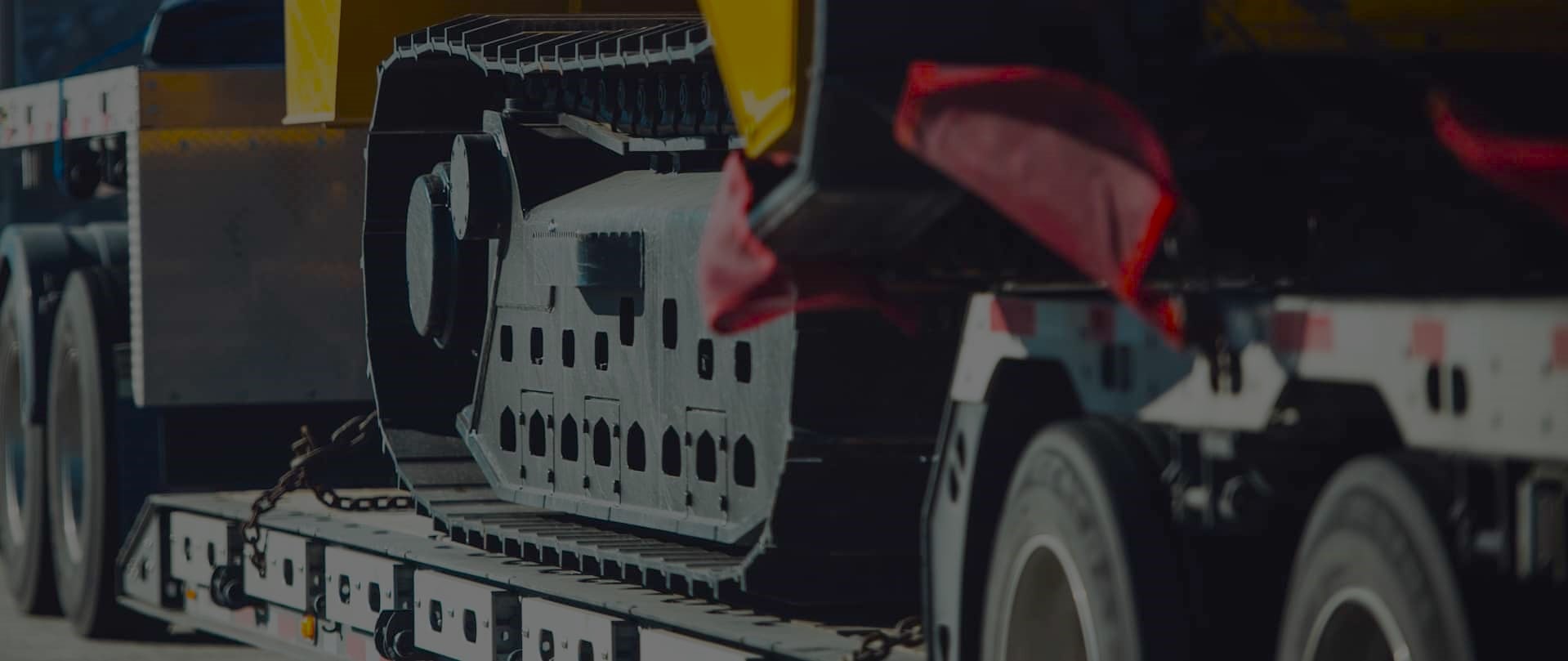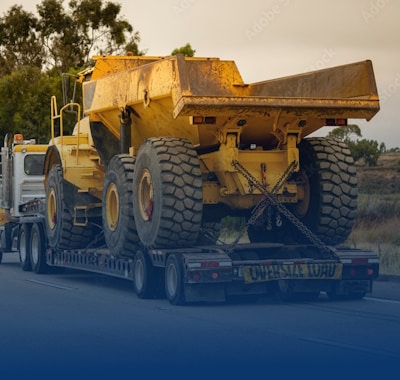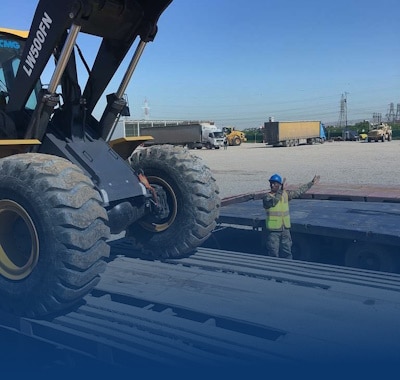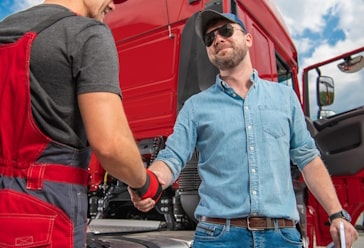Safe Heavy Machinery Transport & Expert Route Planning
Freedom Heavy Haul can offer expedited Pickup and Delivery for any size shipment anywhere in the USA. Contact us today for No Hassle, No Pressure Pricing.
Transporting heavy machinery across the United States needs special skills and careful planning. Whether it’s a big construction vehicle, a sensitive piece of manufacturing gear, or an oversized load, moving it safely is key. Our team of experts ensures your valuable machinery gets to its new home safely, following all laws.
We take a detailed approach to moving heavy equipment. This includes advanced route planning, top-notch safety measures, and knowing how to handle big, heavy, or oversized loads. We take care of everything, from getting the right permits to finding the best route. This way, your valuable assets will arrive on time and in perfect shape.
Understanding Heavy Machinery Transport Requirements and Regulations
Transporting heavy machinery is a complex task. It involves following DOT regulations, getting oversize load permits, and knowing weight limits and transportation laws. It’s important to follow these rules to avoid fines, delays, or legal trouble. Let’s explore the key points for safe and legal heavy machinery transport.
Federal and State Transportation Laws
The U.S. Department of Transportation (DOT) sets federal rules for moving heavy equipment. These rules cover vehicle safety, driver qualifications, and how to secure loads. Each state also has its own laws, which can differ a lot. These laws cover permits, size and weight limits, and where you can go.
Required Permits and Documentation
Getting the right permits is a key part of moving heavy machinery. You might need oversize load permits from state and local authorities. You also need to keep shipping manifests and safety checklists during the journey.
Weight and Size Restrictions
- Weight limits: Heavy machinery must follow strict weight limits to avoid damaging roads and bridges.
- Size restrictions: Oversized loads face height, width, and length limits. These can affect your route and how you transport your equipment.
- Axle weight distribution: It’s important to balance your load correctly. This ensures you follow axle weight restrictions and transport safely.
Understanding DOT regulations, oversize load permits, weight limits, and transportation laws is key for moving heavy machinery. By knowing these rules and following them, you can make sure your equipment gets to its destination safely.
Essential Safety Equipment and Pre-Transport Inspections
Transporting heavy machinery safely is very important. Before you start, make sure you have the right safety gear. Also, do a detailed check of your equipment to avoid risks.
Equipping for Safety
Getting the right safety equipment is key for moving heavy machinery. You’ll need:
- High-visibility vests or jackets to be seen on the road
- Sturdy work boots with steel or composite toes for foot protection
- Gloves to grip equipment securely and prevent hand injuries
- Hard hats to protect against falling objects or overhead hazards
Wearing the right safety gear keeps you safe. It also shows you’re serious about moving heavy equipment safely.
Comprehensive Pre-Transport Inspections
Before you load the machinery, do a detailed pre-trip inspection. This makes sure your equipment is ready for the road. It also lowers the risk of breakdowns or problems during transport. Check:
- Tire condition and inflation levels
- Brakes, lights, and other safety systems
- Proper functioning of tie-down points and load securement mechanisms
- Fluid levels, hoses, and any signs of leakage
By carefully checking your equipment, you can feel confident. Your heavy machinery will be transport safety protocols and ready to safely arrive at its destination.
Heavy Machinery Transport with Safety Checks and Expert Route Handling
Transporting heavy machinery safely is crucial. Experts follow strict safety protocols to ensure your equipment’s safe delivery. They perform detailed safety assessments and use the best load securement methods. This careful planning helps avoid risks and keeps your valuable assets safe.
Professional Safety Assessment Protocols
Our team does thorough inspections before the journey starts. They check the load’s size, weight, and stability. They also look at the route and any obstacles. By planning ahead, we make sure the transport goes smoothly.
Load Securing Best Practices
- They use special equipment like tie-down straps and chains to keep the machinery in place.
- They make sure the load is balanced and stable on the transport vehicle.
- They check the load often during the journey to make any needed adjustments.
Real-time Monitoring Systems
We offer real-time tracking to keep you updated on your equipment’s location. Our advanced GPS and communication systems let us quickly handle any issues. This ensures your machinery reaches its destination safely.
Our heavy machinery transport service focuses on expert route management and safety. You can trust that your equipment is in good hands, from start to finish.
Choosing the Right Transport Vehicle for Your Equipment
Choosing the right vehicle to move heavy machinery is key. The size and weight of your equipment will guide your choice. Let’s look at some specialized trailers and heavy-duty trucks for moving equipment.
Specialized Trailers for Efficient Equipment Transport
The lowboy trailer is a top pick for heavy equipment transport. It has a low deck for easy loading and unloading of big items like excavators and bulldozers. Lowboys can handle a lot of weight, making them perfect for construction and industrial equipment.
The equipment transporter is also a favorite. It has a hydraulic gooseneck and a low-profile deck. This setup safely moves a variety of equipment, from skid steers to smaller backhoes and loaders.
- Lowboy trailers: Ideal for heavy, oversized equipment
- Equipment transporters: Versatile for a variety of machinery
- Heavy-duty trucks: Essential for maneuvering and navigating narrow job sites
When picking a transport vehicle, think about your equipment’s size, weight, and how it’s set up. Also, consider the job site’s needs. Talking to heavy equipment transport experts can help you find the best fit for your equipment.
Professional Route Planning Strategies and Tools
Transporting heavy machinery needs a detailed plan for routes. Experts use top-notch GPS systems to find the best paths. They make sure to steer clear of roads and bridges that can’t handle the weight.
Advanced GPS Navigation Systems
GPS technology is key for moving heavy machinery. It gives real-time updates on road conditions and weight limits. This helps transporters choose safe and efficient routes, avoiding delays and detours.
Bridge and Road Weight Restrictions
It’s vital to know the weight limits of roads and bridges when moving heavy machinery. Experts check these limits and clearance needs. They ensure their oversized loads can move safely without breaking rules or causing damage.
Alternative Route Planning
- Have backup plans for road closures or weight limits.
- Find routes that fit the size and weight of your equipment.
- Keep up with construction, weather, and other route changes.
Using GPS, detailed planning, and flexible strategies, experts safely move heavy machinery. They make sure it reaches its destination efficiently.
Loading and Unloading Procedures for Heavy Equipment
Transporting heavy machinery needs careful planning and execution. This ensures the safe loading and unloading of your valuable equipment. Specialized ramps and lift systems and securing cargo best practices are key. Each step is crucial for the successful transfer of your heavy machinery onto and off transport vehicles.
Before starting, make sure you have the right equipment. This includes heavy-duty ramps, cranes, forklifts, and tie-down straps. These are designed to securely load and unload equipment. Always check the equipment to make sure it’s suitable and safe for the task.
Proper Loading Techniques
Here are the steps to follow when loading heavy machinery:
- Check the terrain and make sure it’s level and stable for the ramps or lift systems.
- Align the ramps or lift systems with the transport vehicle’s platform for a smooth transition.
- Load the equipment slowly and carefully to keep it stable and in control.
- Use high-quality tie-down straps, chains, or other approved cargo securing methods to secure the equipment.
Efficient Unloading Procedures
The unloading process also needs careful attention:
- Check the unloading area to make sure it’s level and free of obstacles.
- Remove the tie-down straps and other securing cargo to prepare for equipment unloading.
- Guide the machinery down the ramps or lift system slowly and steadily, keeping control.
- Make sure the equipment is properly positioned and stable before releasing it from the transport vehicle.
By following these best practices for heavy machinery loading and equipment unloading, you can reduce risks. This protects your valuable assets and ensures a smooth transportation experience.
Weather Considerations and Emergency Protocols
Transporting heavy machinery needs careful planning, especially with unpredictable weather. It’s key to keep your cargo and drivers safe. Good emergency plans and communication systems help deal with weather issues.
Adverse Weather Planning
Check the weather forecast before you start your journey. Look out for dangers like rain, snow, or extreme temperatures. Make plans for these situations.
Make sure your vehicles are ready for bad weather. This includes chains, tarps, and emergency kits.
Emergency Response Procedures
Have a plan for emergencies like breakdowns or bad weather. Teach your drivers how to safely stop and call for help. They should know how to secure the load and contact emergency services.
Train your team often to keep them ready for emergencies.
Communication Systems
Good communication is vital when moving heavy machinery, especially in bad weather. Use reliable devices like two-way radios or satellite phones. This way, you can share updates and respond quickly to problems.
Keep your drivers, dispatch, and other services in touch. This ensures a fast and effective response to any issues.
By focusing on weather, emergency plans, and communication, you can safely move heavy machinery. This is true even when the weather is unpredictable.
Cost Factors in Heavy Equipment Transportation
Transporting heavy machinery can get expensive fast. Costs include transport pricing and equipment moving costs. Knowing what affects these costs helps manage your budget better.
The distance to transport the equipment is a big factor. Longer trips mean higher freight rates. The size and weight of the machinery also matter. Oversize or oversize load fees apply for equipment that’s too big or heavy, needing special handling and permits.
- Transportation distance
- Equipment size and weight
- Specialized permits and handling requirements
Other costs include the type of transport vehicle and any extra safety gear. The route planning also affects costs. Using professional route optimization can save money by finding the best routes.
“Careful planning and understanding the cost factors can help you budget effectively for your heavy equipment transportation needs.”
Knowing these costs helps you plan your budget better. This way, you can make smart choices when moving your heavy machinery. It ensures a smooth and affordable transport experience.
Insurance Requirements and Risk Management
When moving heavy machinery, the right insurance is key. It protects your investment and reduces risks. Knowing about cargo and liability insurance helps you make smart choices in the transport world.
Coverage Types and Limits
Cargo insurance keeps your equipment safe during transport. It covers damages or losses. Make sure the coverage limits match your machinery’s value. Liability insurance also protects you from accidents, saving you from expensive lawsuits.
Liability Considerations
Understanding your liability is vital when moving heavy machinery. Think about your equipment’s size, the transport routes, and how they might affect others. By addressing these risks early, you can keep your cargo and others safe.
Claims Processing Procedures
If something goes wrong during transport, knowing how to handle claims is crucial. Learn what your insurance needs from you and what to do after an incident. Being ready helps you deal with claims quickly, keeping your business running smoothly.







